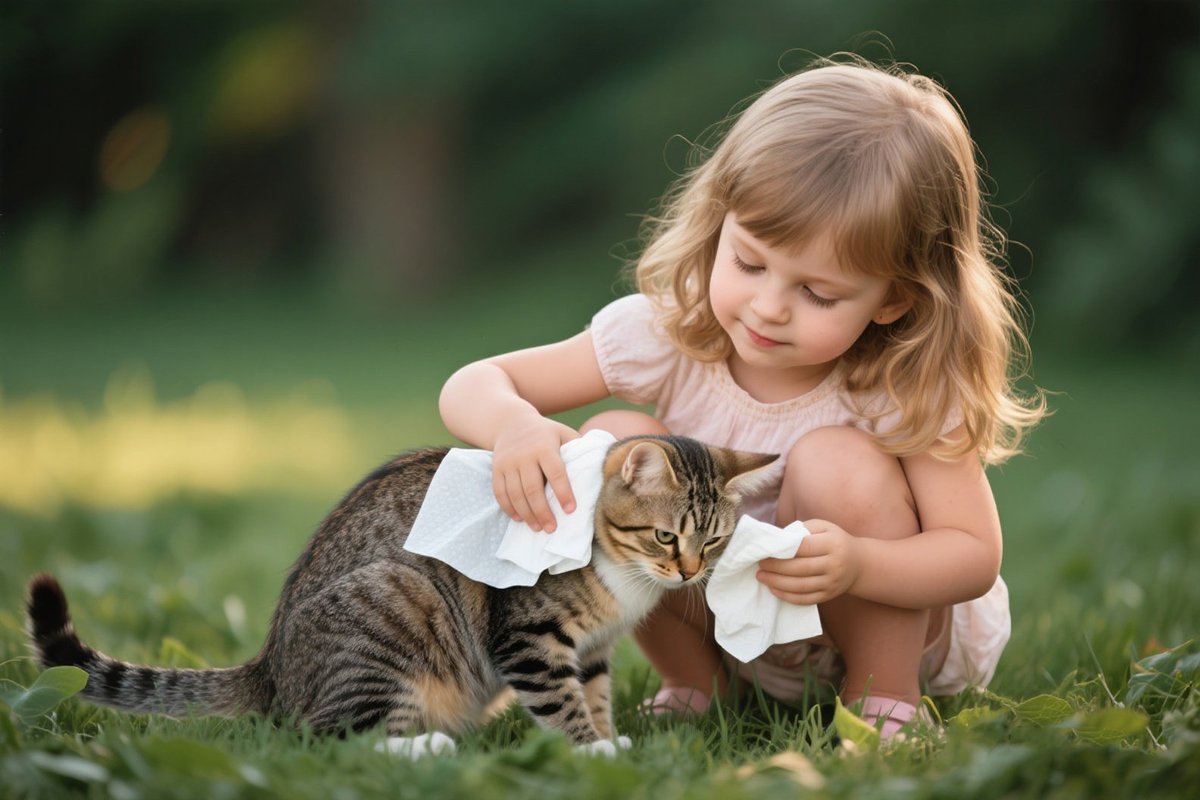“What wipes are safe for my cat?” It’s a question born out of love and, often, a moment of messy necessity – a post-litter box mishap, a muddy paw print trail, or an unexpected encounter with something unpleasant. The sheer volume of wipe options lining store shelves and flooding online marketplaces can be paralyzing. One wrong choice, one seemingly harmless ingredient, can lead to consequences ranging from mild skin irritation to serious health issues. Let me, from our unique vantage point inside the industry, cut through the confusion and provide clarity.
Why the Sudden Panic? The Hidden Dangers in the Ordinary
Think about it for a moment. You reach for a wipe – perhaps a baby wipe, a household surface cleaner, or even a “natural” human body wipe – thinking it’s gentle enough. This is where the danger often begins, suddenly and silently. Cats are not small humans. Their physiology is fundamentally different. Their skin is thinner and more sensitive than ours. Crucially, they are compulsive groomers. Anything you apply to their fur or skin will be ingested.
- Toxic Ingredients Lurking: Many common wipe ingredients are outright poisonous to cats. Phenols (found in some disinfectants), essential oils (especially tea tree, citrus, eucalyptus), alcohol, formaldehyde-releasing preservatives, and artificial fragrances can cause severe reactions. Symptoms can appear suddenly: drooling, vomiting, tremors, lethargy, chemical burns on the skin, or even liver damage. Imagine applying something designed for a countertop onto tissue paper – that’s akin to using the wrong wipe on your cat’s delicate skin.
- pH Catastrophe: Human and baby skin has a different pH balance (slightly acidic) compared to cat skin (more neutral). Using wipes formulated for humans disrupts your cat’s natural skin barrier, the vital shield protecting against infection and dehydration. This disruption isn’t always immediately obvious; it can manifest subtly as chronic dryness, itchiness, or recurrent infections – a slow burn of discomfort for your feline friend.
- The Grooming Gateway: When your cat licks that residue off their fur, those concentrated chemicals go straight into their system. What might cause mild irritation on human skin becomes an internal toxin bomb for a cat. The suddenness of a toxic reaction after grooming is a terrifying reality we’ve heard too many times from devastated owners.
Decoding “Safe”: What Ankang Looks For (And What You Should Demand)
So, what does make a wipe genuinely safe for cats? At Ankang, safety isn’t a marketing buzzword; it’s the bedrock of our formulation philosophy. Here’s the blueprint we follow, and what you should insist upon:
- Veterinarian Approval: This is non-negotiable. Look for explicit statements like “Veterinarian Approved,” “Veterinarian Tested,” or “Recommended by Vets.” This signifies the formulation has been reviewed for feline safety and efficacy. It’s your first line of defense against harmful formulations. We subject every Ankang feline formula to rigorous review by independent veterinary dermatologists.
- Hypoallergenic & Non-Irritating: Seek wipes specifically labeled “Hypoallergenic.” This indicates they are formulated to minimize the risk of allergic reactions, typically achieved by avoiding common irritants like dyes, harsh surfactants (soaps), and strong perfumes. Simplicity is often key.
- pH Balanced for Cats: As mentioned, this is critical. The wipe solution must match the natural pH of feline skin (around 6.2-7.4, essentially neutral). This protects the skin’s acid mantle, preventing dryness and vulnerability. It’s like giving their skin a perfectly balanced drink of water.
- Ingredient Transparency & Safety: Scrutinize the ingredient list! Safe wipes will feature:
- Purified Water: The primary base.
- Gentle Cleansers: Non-soap cleansers derived from coconut or other mild sources.
- Moisturizers: Aloe vera (non-latex), vitamin E, glycerin (pharma-grade), or oat extract to soothe and hydrate, countering any drying effect.
- Safe Preservatives: Necessary to prevent bacterial/fungal growth in the wipe, but must be feline-safe (e.g., potassium sorbate, sodium benzoate in appropriate concentrations – avoiding parabens or MIT/CIT which are common human allergens and increasingly scrutinized).
- NO: Alcohol, phenols, essential oils (except perhaps minute, vet-approved amounts of lavender oil – extracts are usually safer), sulfates (SLS/SLES), artificial dyes, or strong synthetic fragrances. Fragrance-free is always the safest bet, though some very mild, specifically cat-safe natural deodorizers might be acceptable.
- Strength & Texture: The wipe itself should be soft, durable, and non-abrasive. Flimsy wipes that shred leave lint and frustrate you; rough textures can irritate delicate skin. We use high-quality, spunlace non-woven fabric designed for gentle contact.
Navigating the Wipe Aisle: Types of Safe Cat Wipes
Not all cat-safe wipes are created equal! Understanding the different types helps you choose the right tool for the job:
- General Grooming & Cleaning Wipes: These are your versatile workhorses. Safe for light overall cleaning, removing light dirt or dander, freshening up between baths, and gentle post-litter cleaning (focusing on paws/fur, not the genital area). Look for “all-over” or “grooming” labels with the safety features above. Ankang’s Daily Care line fits here – simple, effective, ultra-gentle.
- Paw & Pad Wipes: Paws pick up everything – litter dust, outdoor grime, household cleaners. These wipes are often slightly more textured to effectively clean between toes and pads without being harsh. They may have slightly stronger (but still safe) cleansing agents. Crucial for preventing licking of harmful residues tracked indoors. Think of them as doormats for your cat’s feet!
- Sensitive Skin & Allergy Wipes: Formulated with extra soothing ingredients (colloidal oatmeal, chamomile) and often fragrance-free. Ideal for cats prone to skin irritation, allergies, or recovering from conditions. Minimalist ingredient lists are key here. Formulating these requires an almost obsessive focus on purity – every single component is scrutinized for potential to trigger sensitivity.
- Deodorizing Wipes: Designed to tackle stronger odors (e.g., from anal gland expression or urine accidents). Extreme caution is needed! They must still be non-toxic and safe for licking. Avoid any relying on heavy masking fragrances; look for natural odor neutralizers like activated charcoal or specific enzymes. Effectiveness should never compromise safety. The sudden urge to mask a strong smell can lead to dangerous choices – resist it!
- Ear & Eye Wipes (Specialized): These are highly specific. Only use wipes explicitly labeled and formulated for ears or eyes. They are typically saline-based or use extremely mild, isotonic solutions. Never use a general body wipe near eyes or ears! The risk of irritation or introducing contaminants is too high. This is one area where a sudden DIY approach is a recipe for a vet visit.

How to Use Cat Wipes Safely and Effectively: Ankang’s Best Practices
Safety isn’t just about the wipe in the package; it’s about how you use it:
- Spot Test First: Even with a safe wipe, individual cats can react. Before widespread use, gently wipe a small, inconspicuous area (like the inner leg) and wait 24 hours. Watch for redness, itching, or swelling. Sudden reactions, though rare with proper wipes, do happen.
- Avoid Sensitive Areas: Never use wipes directly on eyes, inside ears, nostrils, or the genital/anal mucosa. Use wipes specifically designed for those areas if needed, or stick to damp cloths with plain water or a vet-recommended cleaner for genitals/anus.
- Gentle Does It: Wipe gently! Don’t scrub. You’re cleaning the fur and skin surface, not sanding wood. For paws, gently clean between the pads.
- Minimize Residue: While safe wipes are designed to leave minimal residue, it’s good practice to gently go over the area with a soft, dry cloth afterward, especially if your cat is a vigorous groomer. This reduces the amount they might ingest.
- Storage Matters: Keep the package sealed tightly to prevent wipes from drying out. Store according to package instructions (often room temperature, away from direct sun/extreme heat).
- Listen to Your Cat: If your cat strongly resists, becomes distressed, or shows any sign of discomfort (hissing, pulling away, skin twitching), stop immediately. Forcing the issue creates negative associations. Try again later or consider if a damp cloth might be less stressful.
The Ankang Commitment: Beyond Just Wipes
Our journey at Ankang started because we saw too many cats suffering from reactions to poorly formulated products. We don’t just manufacture wipes; we obsess over feline dermatology and toxicology. Every ingredient is vetted not just for immediate safety, but for long-term tolerance. We conduct rigorous stability and preservative efficacy testing. We collaborate closely with veterinarians. Why? Because your cat isn’t just a customer; they’re a beloved family member deserving of uncompromising safety. The sudden realization that a common household product could harm them is terrifying – we aim to be the antidote to that fear, providing genuine peace of mind in every pouch.
Conclusion: Safety is Not Optional
Choosing the right wipe for your cat is a critical decision impacting their immediate comfort and long-term health. The confusion in the marketplace is real, and the potential for sudden harm from inappropriate products is significant. By understanding the dangers, knowing what “safe” truly means (veterinarian approval, pH balance, non-toxic ingredients), selecting the right type for the job, avoiding the pitfalls of misleading “natural” claims and risky DIY solutions, and using wipes correctly, you can confidently incorporate them into your cat’s care routine. Look for the signs of true safety, demand transparency, and trust reputable brands like Ankang that prioritize feline well-being above all else. Your cat’s delicate skin and unique biology deserve nothing less than meticulously crafted, genuinely safe hygiene solutions. Let’s wipe away the risks together.
Frequently Asked Questions (FAQs)
- Q: Can I use baby wipes on my cat in an emergency?
A: We strongly advise against it. While some sensitive, fragrance-free baby wipes might not cause immediate harm, they are not pH-balanced for cats and often contain ingredients (like certain mild cleansers or preservatives) that can cause irritation or be unsafe if ingested during grooming. It’s simply not worth the risk. Keep a pack of vet-approved cat wipes on hand for true emergencies. - Q: Are “water wipes” (mostly water) safe for cats?
A: Pure water wipes (literally just water and maybe one preservative) are generally the safest human wipe alternative if you have absolutely nothing else. However, water alone doesn’t effectively clean oils or grime, and the preservative might still be an irritant. More importantly, they lack any gentle cleansing or conditioning agents. Purpose-made cat wipes are significantly more effective and still safe. - Q: How often is it safe to use wipes on my cat?
A: For most cats, using wipes a few times a week for spot cleaning (paws, light body dirt) is fine. Daily use might be suitable for specific needs (e.g., cleaning paws of an indoor-outdoor cat, managing mild incontinence) if using a very gentle, hypoallergenic formula. However, over-wiping, even with safe products, can potentially dry out the skin. Observe your cat’s skin condition. If in doubt, consult your vet. - Q: My cat licked the area right after I used a wipe. Should I be worried?
A: If you used a veterinarian-approved, cat-safe wipe (like Ankang’s), ingestion of small amounts of residue from normal grooming is generally what the product is designed for and should not cause concern. This is why the non-toxic formulation is paramount. However, if you used a non-cat-specific wipe, notice your cat acting strangely (lethargy, drooling, vomiting), or used a large amount of any wipe, contact your veterinarian or pet poison control immediately. - Q: Can cat wipes replace baths entirely?
A: Generally, no. Wipes are excellent for maintenance, spot cleaning, freshening up, and paw cleaning between baths. However, for a heavily soiled cat, significant matting, or certain skin conditions requiring medicated treatment, a full bath with appropriate cat shampoo is necessary. Wipes cannot penetrate deep into the coat or provide the same level of cleansing as a proper bath. Think of wipes as a fantastic supplement, not a complete replacement.





